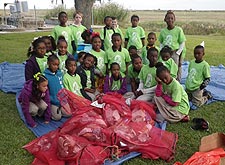 A class of 30 fourth graders from Upper Pointe Coupee Elementary traveled to Cameron Parish in November to learn about watersheds, wetlands, the environment and how marine debris impacts nature. The students came to learn more about the coast and how they affect it. At Rockefeller Refuge they discussed and learned about watersheds and how trash reaches the Gulf of Mexico and Louisiana’s coast. A class of 30 fourth graders from Upper Pointe Coupee Elementary traveled to Cameron Parish in November to learn about watersheds, wetlands, the environment and how marine debris impacts nature. The students came to learn more about the coast and how they affect it. At Rockefeller Refuge they discussed and learned about watersheds and how trash reaches the Gulf of Mexico and Louisiana’s coast.
Once the students arrived at Rutherford Beach, they were met by Kevin Savoie, local Sea Grant Agent, who talked to them about cheniers, their formation and about the beach. The students learned that the sand is actually shell hash - or broken shell - and not actual sand like what is found on most beaches. Each student was given a 2013 Beach Sweep towel as a gift from Cameron Parish for assisting with cleaning beaches.
On the beach they collected data on marine debris and methodically counted and recorded debris in 10 meter-wide plots that stretched into the dunes. Then they conducted a small beach cleanup. Students noticed a lot of plastic bottles, cans, pieces of plastic and cans. This field trip to the coast was for many of the students, and adults, the first time that they have been to marshes or the beach and have seen the Gulf of Mexico.
Back at Rockefeller Refuge they sorted debris into categories (plastic, metal, glass, fishing gear, wood, paper, Styrofoam, clothing and rubber). They weighed their findings and then discussed what they saw and learned. Back in the classroom they were tasked with tallying up their data and create graphs to explain their findings.
In the beach cleanup they picked up a total of 29.75 pounds of marine debris composed of:
- 8 pounds of plastic
- 0.5 pounds of Styrofoam,
- 7.5 pounds of glass
- 3 pounds of aluminum
- 0.75 pounds of metal
- 12.75 pounds of “garbage” (mixed and unidentified contents non recyclable plastic)
The project is a part of a sustainability grant awarded to the Environmental Education Commission and funded by EPA. Teachers from Region 6 states (Louisiana, Arkansas, Texas and New Mexico) are included in the project. Marine debris is a persistent problem globally and is something that can be easily understood by children.
.
Back
to Main |